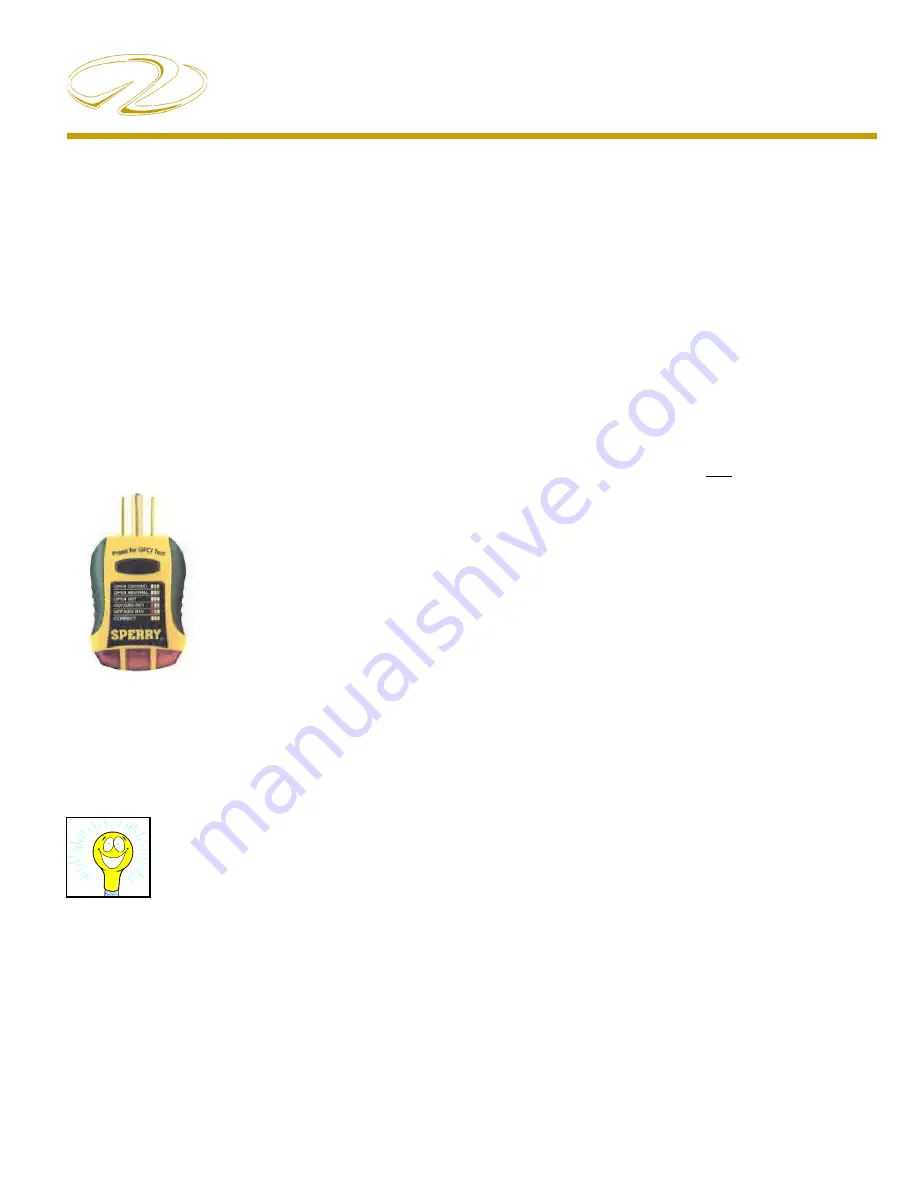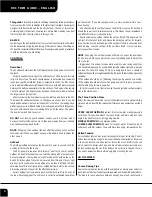
59
Systems
Ignition Protected Devices
Many electrical devices in everyday use tend to “arc”
or spark when being used. These include motors, fans,
switches, relays, etc.
Boats in general use many of these same devices but they
are protected from any sparking that may cause the device
to ignite with any vapors that are typically found in the
engine room and/or fuel tank compartments.
When replacing any electrical device especially in the
bilge or engine room make sure it is ignition protected.
This means it has been tested and normally the device
is stamped with a marking making it safe to use. Most
automotive type devices are
not
ignition protected
especially engine starters and alternators.
Note smaller hose barb for generator feed and return.
POSSIBLE PROBLEMS/SOLUTIONS (GFCI’S)
1. If the “reset” button does not pop out,
the GFCI is probably defective and should
be replaced.
2. If the “reset” button pops out one
time but tends to stick the next the GFCI
should be replaced.
3. The GFCI “reset” button pops out when something
is turned on. This may indicate an internal wiring prob-
lem with the GFCI or there may be a ground-fault down
stream.
4. The GFCI “reset” button is in the pressed position and
nothing works. Check the appropriate breaker at the main
ship’s AC control panel to make sure it has not “tripped”
or as been deactivated.
Also, GFCI downstream recep-
tacles can be tested with a plug-in
type GFCI tester. This tester con-
tains a GFCI test buton which ac-
complishes the same thing as the
GFCI receptacle built-in test but-
ton. This tester can be purchased at
electrical supply houses or marine
retailers.
To test a GFCI fi nd a 120 volt night light or small lamp to
plug into the GFCI outlet. Try it in another circuit fi rst to
make sure it lights.
After the lamp is plugged into the GFCI outlet the lamp
should light. Now press the “test” button at the GFCI
receptacle center. The GFCI’s “reset” button should pop
out and the lamp should go out. This means the GFCI
itself is functioning properly. Press the “reset” button to
restore power to the outlet.
Test each GFCI circuit monthly.
You can use the lamp to check receptacles downstream
from the GFCI. All receptacles should light the lamp and
should go out when the “test” button is pressed.
Testing GFCI’S
Summary of Contents for 32 EXPRESS
Page 1: ...2011 Sport Yacht Collection S Y h C ll 32 EXPRESS OWNER S MANUAL...
Page 3: ...320102 12 6 2013 OWNER S MANUAL 32 EXPRESS...
Page 32: ...11 Safety On Board NAVIGATION LIGHT RULES...
Page 53: ...9 Rules Of The Road...
Page 54: ...10 Chapter 3...
Page 94: ...40 Chapter 4 TYPICAL 12 VOLT HELM SWITCH PANEL...
Page 106: ...52 Chapter 4 TYPICAL ELCI AC CIRCUIT FLOW CHART VOLTS VOLTS VOLTS VOLTS LINE...
Page 148: ...94 Chapter 4...
Page 149: ...95 Systems...
Page 150: ...96 Chapter 4...
Page 151: ...97 Systems...
Page 152: ...98 Chapter 4...
Page 153: ...99 Systems...
Page 154: ...100 Chapter 4...
Page 155: ...101 Systems...
Page 156: ...102 Chapter 4...
Page 157: ...103 Systems...
Page 158: ...104 Chapter 4...
Page 159: ...105 Systems...
Page 180: ...15 Engine Controls AFT FORWARD SIDEWAYS DIAGONALLY ROTATE JOYSTICK FUNCTIONS...
Page 262: ...22 Chapter 8 OVERBOARD DISCHARGE PAN DRAIN TYPICAL VECTOR COMPACT AC SYSTEM AIR FILTER...
Page 276: ...36 Chapter 8...
Page 300: ...9 Troubleshooting STEREO DIAGNOSTIC CHART...
Page 301: ...10 Chapter 9 STEREO DIAGNOSTIC CHART...
Page 302: ...11 Troubleshooting STEREO DIAGNOSTIC CHART...
Page 303: ...12 Chapter 9 TACHOMETER ELECTRONIC DIESEL...
Page 304: ...13 Troubleshooting TACHOMETER ELECTRONIC DIESEL...
Page 307: ...16 Chapter 9 THRUSTER BOW...
Page 309: ...18 Chapter 9 TYPICAL WINDLASS...
Page 329: ...6 Chapter 12 TECHNICAL DRAWINGS...
Page 330: ...Technical Information 12 7 32 EXPRESS GALVANIC ISOLATOR WIRING...
Page 331: ...Technical Information 12 8 TYPICAL NMEA 2000 NETWORK COMPONENTS...
Page 332: ...Technical Information 12 9 32 EXPRESS ELCI AC CIRCUIT FLOW CHART TYPICAL...
Page 333: ...Technical Information 12 10 32 EXPRESS MAIN AC SHIP S PANEL FRONT VIEW...
Page 334: ...Technical Information 12 11 32 EXPRESS MAIN AC SHIP S PANEL REAR VIEW...
Page 335: ...Technical Information 12 12 32 EXPRESS MAIN DC SHIP S PANEL FRONT VIEW...
Page 337: ...Technical Information 12 14 32 EXPRESS COCKPIT SWITCH PANEL...
Page 338: ...Technical Information 12 15 32 EXPRESS BATTERY VSR CIRCUITRY...
Page 339: ...Technical Information 12 16 32 EXPRESS BATTERY MANAGEMENT PANEL...
Page 340: ...Technical Information 12 17 32 EXPRESS HELM SWITCH PANEL...
Page 341: ...Technical Information 12 18 32 EXPRESS HELM BREAKER PANEL...
Page 342: ...Technical Information 12 19 32 EXPRESS VOLVO IGN MERC ANALOG EVC...
Page 343: ...Technical Information 12 20 32 EXPRESS FIREWALL TO MDP HARNESS ROUTING...
Page 344: ...Technical Information 12 21 32 EXPRESS DECK HARNESS ROUTING FORWARD...
Page 345: ...Technical Information 12 22 32 EXPRESS DECK HARNESS ROUTING AFT...
Page 346: ...Technical Information 12 23 32 EXPRESS HULL HARNESS ROUTING...
Page 347: ...Technical Information 12 24 32 EXPRESS GAUGE PANEL CONFIGURATIONS...
Page 348: ...Technical Information 12 25 32 EXPRESS TYPICAL DC GROUND CIRCUITRY...
Page 349: ...Technical Information 12 26 32 EXPRESS TYPICAL TRIM TAB SWITCH CIRCUITRY...
Page 350: ...Technical Information 12 27 32 EXPRESS TYPICAL BATTERY MANAGEMENT PANEL CIRCUITRY...
Page 351: ...Technical Information 12 28 32 EXPRESS TYPICAL GFCI CIRCUITRY...
Page 352: ...Technical Information 12 29 32 EXPRESS TYPICAL FIRE EXTINGUISHER GROUND CIRCUITRY...
Page 353: ...Technical Information 12 30 32 EXPRESS STEREO BLUETOOTH WIRING...
Page 357: ...Technical Information 12 34 32 EXPRESS MACHINERY LAYOUT...
Page 358: ...Technical Information 12 35 32 EXPRESS FUEL TANK EPA COMPLIANT...
Page 361: ...Technical Information 12 38 32 EXPRESS COCKPIT SEATING POSITION PLAN...
Page 362: ...Technical Information 12 39 32 EXPRESS RANGE OF VISIBILITY...
Page 363: ...Technical Information 12 40 32 EXPRESS DIMENSIONS APPROXIMATE...
Page 364: ...Technical Information 12 41 32 EXPRESS BOW PLAN WINDLASS...
















































